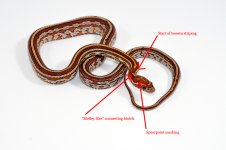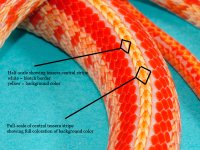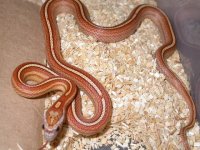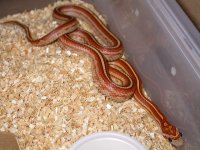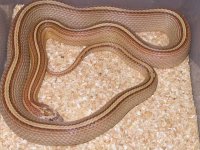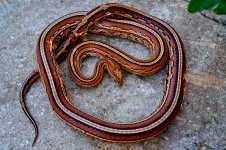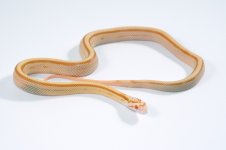-
Hello!
Either you have not registered on this site yet, or you are registered but have not logged in. In either case, you will not be able to use the full functionality of this site until you have registered, and then logged in after your registration has been approved.
Registration is FREE, so please register so you can participate instead of remaining a lurker....
Please be certain that the location field is correctly filled out when you register. All registrations that appear to be bogus will be rejected. Which means that if your location field does NOT match the actual location of your registration IP address, then your registration will be rejected.
Sorry about the strictness of this requirement, but it is necessary to block spammers and scammers at the door as much as possible.
You are using an out of date browser. It may not display this or other websites correctly.
You should upgrade or use an alternative browser.
You should upgrade or use an alternative browser.
Motley Tessera vs. Stripe Tessera
- Thread starter Walter Smith
- Start date
The_Saiyajin
Not a human...
Yes I meant that some posts ago. Problem is that the anery tessera motley striped and my two toffee tessera stripeds break the rule 
HerpsOfNM
My name's Blurryface...
Here's what I was talking about with the scalation of the central background-colored stripe...
Don't mind the ugliness of the snake. She's supposedly a RO tessera that's purportedly het ghost. That ugly as sin ghost stripe I have from Steve Roylance is slated to play with her in 2015.
If I remember how to do scale counts correctly for keying out snakes, the full-scale is scale #1, the half-scale would be scale #2. keyboard crapped out and I had to restart computer.
So the scale count for the tesserae central stripe would be scales 1 and half of 2. Then the actually genetically-modified blotch that now forms a stripe would be scales half of 2, 3, 4, 5, and half of 6.
Don't mind the ugliness of the snake. She's supposedly a RO tessera that's purportedly het ghost. That ugly as sin ghost stripe I have from Steve Roylance is slated to play with her in 2015.
If I remember how to do scale counts correctly for keying out snakes, the full-scale is scale #1, the half-scale would be scale #2. keyboard crapped out and I had to restart computer.
So the scale count for the tesserae central stripe would be scales 1 and half of 2. Then the actually genetically-modified blotch that now forms a stripe would be scales half of 2, 3, 4, 5, and half of 6.
Attachments
Walter Smith
CRAZY BOUT' CORNS !!
More fun, and photographically what I was describing via head and neck markings...
I'll do similar to the attached photo as what I was describing about the central background-color stripe and scale counting...
Thanks for the visual, it helps to understand a bit more.
I'm wondering if the CENTER stripping could tell us something?
As you can see in my first two pics. ( Motley Tesseras ) there is a dot/dash off the head, then the CENTER stripe starts on the neck...........
then in my 3rd. pic. ( Stripe Tessera ) that dot/dash is not there and pretty much just starts the CENTER stripe off the head.
Walter
:crazy02:BOUT' CORNS !!
Attachments
HerpsOfNM
My name's Blurryface...
What would be even more helpful, Walter, would be those that have known motley tesseras (animals with no known stripe gene present) and those with striped tesseras (with no known motley gene present) to toss up photos. Something is telling me though, that the head patterning of the dot/dash won't be a marker, as this guy trumps it....I know multicorn has quite a few striped tesseras IIRC.
Nanci's very own Gartersnake...where he is a "normal" (=non-motley or stripe) okeetee tessera with an almost fully striped back head marking. Annnnnnnnnd....I have to get back to packing.
Nanci's very own Gartersnake...where he is a "normal" (=non-motley or stripe) okeetee tessera with an almost fully striped back head marking. Annnnnnnnnd....I have to get back to packing.
Attachments
Walter Smith
CRAZY BOUT' CORNS !!
what about bellys? something spezial? Actually tessera does a lot of cool stuff with the checkers but I am really ashamed I dont have in my head, if all of my striping tessis have a clean white belly.
I wouldn't think the bellys would tell us anything???
Seeing that NON-Tessera Motleys & Stripe both have patternless bellys, plus I just went and check on my Tesseras ( ones I have pictured in OP ) and they all have patternless bellies as well.
Walter
:crazy02:BOUT' CORNS !!
The_Saiyajin
Not a human...
I can provide pics of perect striped normal tesseras as well if it would help.
So far I have 5 tessera stripeds here which i can photograph the next days. Just tell me what exactly u want to see and to have. But I dont have macro but when i use raw and cut the picture later i can make good shots from the areas you want to see.
So far I have 5 tessera stripeds here which i can photograph the next days. Just tell me what exactly u want to see and to have. But I dont have macro but when i use raw and cut the picture later i can make good shots from the areas you want to see.
The_Saiyajin
Not a human...
yes walter you are right. all white bellys
Walter Smith
CRAZY BOUT' CORNS !!
What would be even more helpful, Walter, would be those that have known motley tesseras (animals with no known stripe gene present) and those with striped tesseras (with no known motley gene present) to toss up photos. Something is telling me though, that the head patterning of the dot/dash won't be a marker, as this guy trumps it....I know multicorn has quite a few striped tesseras IIRC.
Nanci's very own Gartersnake...where he is a "normal" (=non-motley or stripe) okeetee tessera with an almost fully striped back head marking. Annnnnnnnnd....I have to get back to packing.
I 100% agree and that's what I was hoping for.
To see some Tessera Motleys with 100% certainty of not having the Stripe trait.......even in het form......and visa-versa and compare those pics.
Becasue let's face it, I'm sure there are alot out there that have Motleys in their collection that could be het for Stripe and not know it if the right pairing is not done and if those Motleys were used in a Tessera breeding project................well, goes back to my thoughts on your outcome
That may give us something to look for visually that could help???
Walter
:crazy02:BOUT' CORNS !!
HerpsOfNM
My name's Blurryface...
I can provide pics of perect striped normal tesseras as well if it would help.
So far I have 5 tessera stripeds here which i can photograph the next days. Just tell me what exactly u want to see and to have. But I dont have macro but when i use raw and cut the picture later i can make good shots from the areas you want to see.
That would be very helpful, particularly if you are 10000000% certain that your motley tesseras have no stripe lineage, and vice versa with your striped tesseras having no motley lineage.
I 100% agree and that's what I was hoping for.
To see some Tessera Motleys with 100% certainty of not having the Stripe trait.......even in het form......and visa-versa and compare those pics.
Becasue let's face it, I'm sure there are alot out there that have Motleys in their collection that could be het for Stripe and not know it if the right pairing is not done and if those Motleys were used in a Tessera breeding project................well, goes back to my thoughts on your outcome
That may give us something to look for visually that could help???
Walter
:crazy02:BOUT' CORNS !!
Exactly!
It would definitely give us something to start looking for. As it stands we're somewhat hashing out a foundation. I'm honestly surprised it's taken, what 5, almost 6 years to even do this with the tessera gene. I think it was '08 that the tesseras came about, at least to the point of selling them. I saw my first in 2009 at the February NARBC show, back when they were $1500 for hatchlings. :flames: :angry01:
Walter Smith
CRAZY BOUT' CORNS !!
That would be very helpful, particularly if you are 10000000% certain that your motley tesseras have no stripe lineage, and vice versa with your striped tesseras having no motley lineage.
Exactly!
It would definitely give us something to start looking for. As it stands we're somewhat hashing out a foundation. I'm honestly surprised it's taken, what 5, almost 6 years to even do this with the tessera gene. I think it was '08 that the tesseras came about, at least to the point of selling them. I saw my first in 2009 at the February NARBC show, back when they were $1500 for hatchlings. :flames: :angry01:
I agree.
I just think if we could figure this out, there will not be upset people down the line who purchased a Stripe Tessera for a special project only to find out they actually have a Motley Tessera and have to go through what we are right now
Walter
:crazy02:BOUT' CORNS !!
Walter Smith
CRAZY BOUT' CORNS !!
What would be even more helpful, Walter, would be those that have known motley tesseras (animals with no known stripe gene present) and those with striped tesseras (with no known motley gene present) to toss up photos. Something is telling me though, that the head patterning of the dot/dash won't be a marker, as this guy trumps it....I know multicorn has quite a few striped tesseras IIRC.
Nanci's very own Gartersnake...where he is a "normal" (=non-motley or stripe) okeetee tessera with an almost fully striped back head marking. Annnnnnnnnd....I have to get back to packing.
After looking at pics. posted in this thread some more, you may be right, but I'm still wondering about this dot/dash thing.
Could it be possible that Tesseras ( as the one you posted ) & Stripe Tesseras NOT have this dot/dash and Motley Tesseras do, simply because of the Motley trait being there in homo form ????
Here are pics. of Chris' & My Stripe Tesseras and notice, they both do NOT have the dot/dash ( and also extremely clean latterals ) ..........HMMMMMM
BTW, my guy was produced by and aquired from Steve and he was obtained as a Stripe Tessera.
Walter
:crazy02:BOUT' CORNS !!
Attachments
Buzzard
two corny
Hey guys sorry I am late to the party. Here are some pics to compare. Not sold on the dot/dash thing or the stripe through the tail. But maybe by getting a lot of pics we will be able to see something we haven't noticed before 
Normal Tessera with dot/dash thingy. Love this head pattern too.
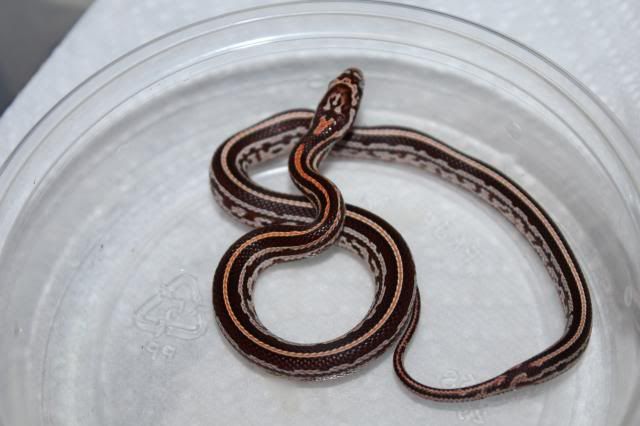
Normal Tessera without dot/dash thingy and stripe through the tail.
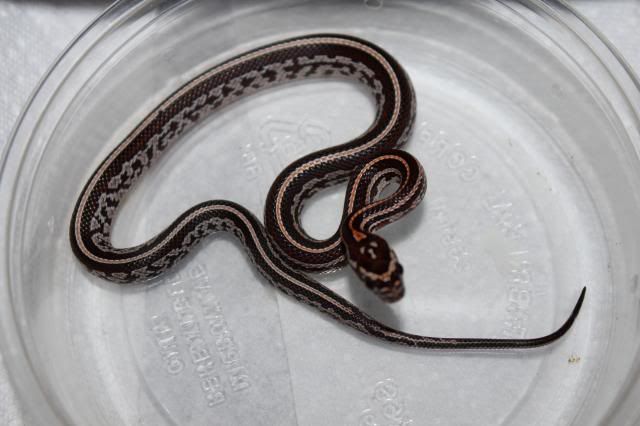
"Suspected" Striped Tessera

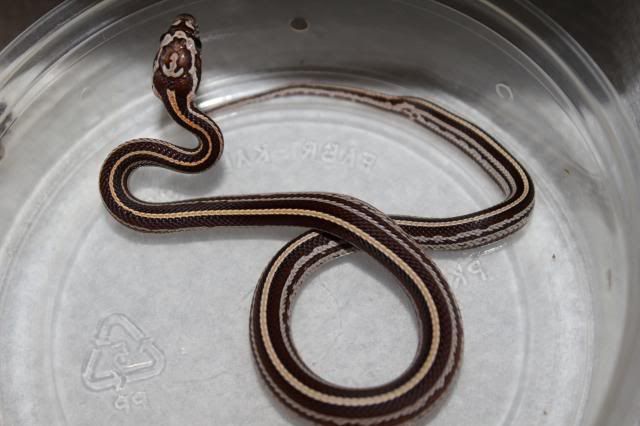
These guys are from the Alabama line. Normal Tessera het Stripe and a Alabama Tessera(outcross) unk hets
Buzz
Normal Tessera with dot/dash thingy. Love this head pattern too.

Normal Tessera without dot/dash thingy and stripe through the tail.

"Suspected" Striped Tessera


These guys are from the Alabama line. Normal Tessera het Stripe and a Alabama Tessera(outcross) unk hets
Buzz
vetusvates
Gamaliel's Principle
http://c3.unam.mx/images/library/file/Notas/jezb22007.pdf
http://dev.biologists.org/content/131/24/6053.full
My brain keeps coming back to what I have been reading for years, and what Chuck Pritzel reiterated here. The 'neural crest migration model' of pattern and color expression in phenotypes.
I would like to think there exists a perfect answer to Walter's question(s)...or maybe I myself like things tied up in neat packages. I have visited and revisited these articles and this subject in trying to understand stripes and motleys....and then again with the diffused gene, and then again with pied-ness, and then yet again when tesseras came along (and a number of times in between). I do not have the answer but I believe it may begin here. (Although I admit at best that this may only point to what scientifically should happen---according to the calculus level math equations. And thereby perhaps entirely subjective and undetectable to the naked eye in a live specimen, by the way.) At first (long ago) I thought it was counterintuitive that pattern would be most uniform down the middle of the back, formed latest in time...but then I realized these were neural crest cells with the least distance to migrate. This does not conflict with the notion that less lateral (down the side) irregularity exists in a snake (that if NON-tessera) would have the least irregularity. Supporting Saiyajin's description of cleaner neatness laterally in a tessera stripe....and not quite so clean, not quite so neat pigmentation down the sides of a motley tessera. And what is very noticeable, of course, as lots of irregularity in a normal homozygous tessera, no other pattern genes (not even hets) involved.
I am thinking about this strictly academically. And referencing only what has previously been thought about and written about, albeit in other contexts---fish for one example, garter snakes for another. So forgive me if I am stating the obvious...that everyone has already mentally processed and filed away. I personally find Walter's and Saiyajin's and HerpsOfNM's and Buzzard's discussion fascinating.
http://dev.biologists.org/content/131/24/6053.full
My brain keeps coming back to what I have been reading for years, and what Chuck Pritzel reiterated here. The 'neural crest migration model' of pattern and color expression in phenotypes.
I would like to think there exists a perfect answer to Walter's question(s)...or maybe I myself like things tied up in neat packages. I have visited and revisited these articles and this subject in trying to understand stripes and motleys....and then again with the diffused gene, and then again with pied-ness, and then yet again when tesseras came along (and a number of times in between). I do not have the answer but I believe it may begin here. (Although I admit at best that this may only point to what scientifically should happen---according to the calculus level math equations. And thereby perhaps entirely subjective and undetectable to the naked eye in a live specimen, by the way.) At first (long ago) I thought it was counterintuitive that pattern would be most uniform down the middle of the back, formed latest in time...but then I realized these were neural crest cells with the least distance to migrate. This does not conflict with the notion that less lateral (down the side) irregularity exists in a snake (that if NON-tessera) would have the least irregularity. Supporting Saiyajin's description of cleaner neatness laterally in a tessera stripe....and not quite so clean, not quite so neat pigmentation down the sides of a motley tessera. And what is very noticeable, of course, as lots of irregularity in a normal homozygous tessera, no other pattern genes (not even hets) involved.
I am thinking about this strictly academically. And referencing only what has previously been thought about and written about, albeit in other contexts---fish for one example, garter snakes for another. So forgive me if I am stating the obvious...that everyone has already mentally processed and filed away. I personally find Walter's and Saiyajin's and HerpsOfNM's and Buzzard's discussion fascinating.
HerpsOfNM
My name's Blurryface...
**pointing up**
I may have to put my biology degree edjumacashun to some work here. Got anymore reference materials other than what you posted? I can't say I'll have some more light to shed, particularly since I'm in the midst of moving 10 hours east, but I might be able to put some 2 and 2 together with some down time I have coming in a couple days.
On a similar note to address some points in previous posts...
One subtle characteristic that has me scratching my head is within striped corns. I've noticed on a few that where the "motley-like connecting blotch" I pointed out on the tessera (click on underlined for post #41) is faintly present on some striped corns. You can see this subtlety in post #52 above in Walter's striped tessera.
It can also be seen in my butter stripe (see attachment) and within some digging on Ian's Vivarium, as well as within John Finsterwald's (username = zorro) charcoal striped tessera he has on his website. This slight imperfection isn't an identification marker, but is something I've noticed some striped and striped tessera corns have yet others don't. I've not a clue what causes this, not even a guess. And honestly, my brain is toast right now having spent the last 2 hours over at my mom's house for dinner with her, my wife, and mother-in-law, plus the drama my sister brings. :sobstory:
I may have to put my biology degree edjumacashun to some work here. Got anymore reference materials other than what you posted? I can't say I'll have some more light to shed, particularly since I'm in the midst of moving 10 hours east, but I might be able to put some 2 and 2 together with some down time I have coming in a couple days.
On a similar note to address some points in previous posts...
One subtle characteristic that has me scratching my head is within striped corns. I've noticed on a few that where the "motley-like connecting blotch" I pointed out on the tessera (click on underlined for post #41) is faintly present on some striped corns. You can see this subtlety in post #52 above in Walter's striped tessera.
It can also be seen in my butter stripe (see attachment) and within some digging on Ian's Vivarium, as well as within John Finsterwald's (username = zorro) charcoal striped tessera he has on his website. This slight imperfection isn't an identification marker, but is something I've noticed some striped and striped tessera corns have yet others don't. I've not a clue what causes this, not even a guess. And honestly, my brain is toast right now having spent the last 2 hours over at my mom's house for dinner with her, my wife, and mother-in-law, plus the drama my sister brings. :sobstory:
Attachments
vetusvates
Gamaliel's Principle
HONM, google 'neural crest migration model' (<---or click this link), and you'll find diagrams, schematics, and scholarly articles on how embryos, via pluripotential stem cells, proceed to develop color and patterns, on the cellular level, then on to the macro or phenotypic level, as development progresses.
And I emphasize...I am not trying to over-complicate the nature of this thread...but IMHO understanding the pictures of what we get (the beautiful pictures in this thread) is simpler when we go back to a beginning, and understand pigment and pattern on a cellular level as it progresses toward what we get when an egg hatches.
In addition to the question of hatching and selling a snake as tessera stripe or tessera motley.........I have also seen tesseras (as well as simple striped corns) for sale as het diffuse or homo diffuse. One can only be sure, of course, of this latter question when one knows the precise parentage and avoids possible confusion in snakes that essentially cannot easily be told apart visually (heterozygous or homozygous for the diffuse gene).
People will be perplexed at a minimum...and annoyed or worse at a maximum...to find they have bought snakes that they thought or hoped were homo diffused to be merely het diffused. But that is a whole other thread, same theme, different verse.
And I emphasize...I am not trying to over-complicate the nature of this thread...but IMHO understanding the pictures of what we get (the beautiful pictures in this thread) is simpler when we go back to a beginning, and understand pigment and pattern on a cellular level as it progresses toward what we get when an egg hatches.
In addition to the question of hatching and selling a snake as tessera stripe or tessera motley.........I have also seen tesseras (as well as simple striped corns) for sale as het diffuse or homo diffuse. One can only be sure, of course, of this latter question when one knows the precise parentage and avoids possible confusion in snakes that essentially cannot easily be told apart visually (heterozygous or homozygous for the diffuse gene).
People will be perplexed at a minimum...and annoyed or worse at a maximum...to find they have bought snakes that they thought or hoped were homo diffused to be merely het diffused. But that is a whole other thread, same theme, different verse.
Last edited:
Walter Smith
CRAZY BOUT' CORNS !!
Hey guys sorry I am late to the party. Here are some pics to compare. Not sold on the dot/dash thing or the stripe through the tail. But maybe by getting a lot of pics we will be able to see something we haven't noticed before
Normal Tessera with dot/dash thingy. Love this head pattern too.
Normal Tessera without dot/dash thingy and stripe through the tail.
These guys are from the Alabama line. Normal Tessera het Stripe and a Alabama Tessera(outcross) unk hets
Buzz
Thanks for your post Buzz and welcome to the "trying to figure this out makes my head hurt" thread :headbang:............LOL
**pointing up**
One subtle characteristic that has me scratching my head is within striped corns. I've noticed on a few that where the "motley-like connecting blotch" I pointed out on the tessera (click on underlined for post #41) is faintly present on some striped corns. You can see this subtlety in post #52 above in Walter's striped tessera.
It can also be seen in my butter stripe (see attachment) and within some digging on Ian's Vivarium, as well as within John Finsterwald's (username = zorro) charcoal striped tessera he has on his website. This slight imperfection isn't an identification marker, but is something I've noticed some striped and striped tessera corns have yet others don't. I've not a clue what causes this, not even a guess.
Yeah, I see what you are talking about Chris and now that you mentioned it, I recall seeing this in stripes I have produced over the years.
Well, I guess your ( and Buzz's ) info here pretty much eliminates my thoughts on this being a possible marker........back to square one :awcrap:
Walter
:crazy02:BOUT' CORNS !!
Walter Smith
CRAZY BOUT' CORNS !!
In addition to the question of hatching and selling a snake as tessera stripe or tessera motley.........I have also seen tesseras (as well as simple striped corns) for sale as het diffuse or homo diffuse. One can only be sure, of course, of this latter question when one knows the precise parentage and avoids possible confusion in snakes that essentially cannot easily be told apart visually (heterozygous or homozygous for the diffuse gene).
People will be perplexed at a minimum...and annoyed or worse at a maximum...to find they have bought snakes that they thought or hoped were homo diffused to be merely het diffused. But that is a whole other thread, same theme, different verse.
Hi Eric and welcome.
This is exactly what I'm thinking could happen in the future if we can't get this nailed down.
Walter
:crazy02:BOUT' CORNS !!
gelshark
 
mine are motley/stripe tesseras, was told that we call them striped tesseras, but when I advertise them I disclose what their true genotype is. I did lose a sale since it wasnt a homo striped tessera.
the sire of my clutches is a tessera het motley and the dame is a stripe. babies included motleys and "striped tessera" which were actually motley/stripe tesseras aka trundlefart tesseras aka tesseras het motley het stripe (get the idea?) as well as normals and tesseras. no traditional stripes came out of my clutches. Although none of the offspring has been proven yet, 2014 could be the year to prove some stuff out if the owners of these snakes decide to do so, and i did not hold any back the first year.
the sire of my clutches is a tessera het motley and the dame is a stripe. babies included motleys and "striped tessera" which were actually motley/stripe tesseras aka trundlefart tesseras aka tesseras het motley het stripe (get the idea?) as well as normals and tesseras. no traditional stripes came out of my clutches. Although none of the offspring has been proven yet, 2014 could be the year to prove some stuff out if the owners of these snakes decide to do so, and i did not hold any back the first year.
vetusvates
Gamaliel's Principle
Hey guys sorry I am late to the party. Here are some pics to compare. Not sold on the dot/dash thing or the stripe through the tail. But maybe by getting a lot of pics we will be able to see something we haven't noticed before
Normal Tessera with dot/dash thingy. Love this head pattern too.
Normal Tessera without dot/dash thingy and stripe through the tail.
"Suspected" Striped Tessera
These guys are from the Alabama line. Normal Tessera het Stripe and a Alabama Tessera(outcross) unk hets
Buzz
IMHO, I see more commonality in Buzz's first two (blue highlighted) pics than difference. I don't know if I would call it dot-dashing or non-dot-dashing, it seems to be present sporadically in both---as I squint at the entire length of the two snakes. (Maybe call it lateral irregular side blotch remnant...lol.) But it is consistent with Nanci's garter snake in that there is a profusion of 'side blotch' element remnant present...expected from GS's okeetee origins.
The real problem...is Buzz's tessera stripe. A beautiful little snake. It has very obvious lateral stripes, very neat..but not "clean sides". Not like the clean lateral sides of Walter's and Saiyajin. What did these latter two look like as hatchlings?
Reminds me that homo diffusion looks different on different snakes...depending on their family tree (and morph). Some fires highly diffused, some minimally...depending on family tree.
Just like selectively-breeding striped snakes can reduce lateral blotch remnant to nothing (like Nanci's beautiful pinstripes with totally clean sides), and even to the disappearing stripe extreme...also depending on family tree.
So, I still think Saiyajin is on to something.

